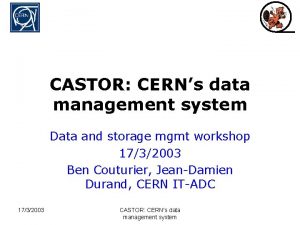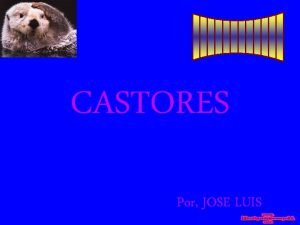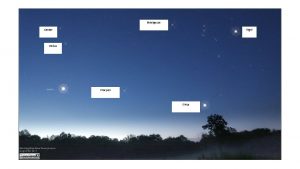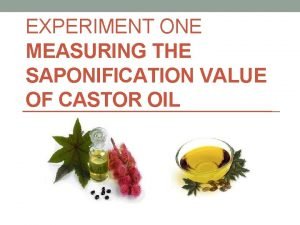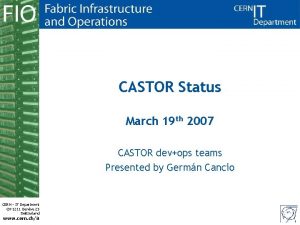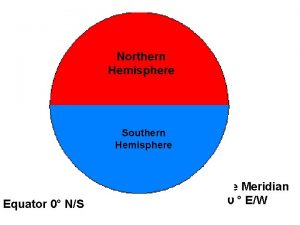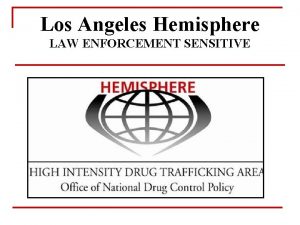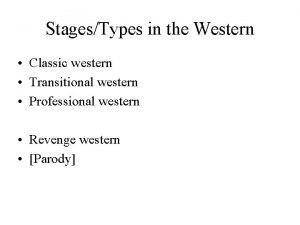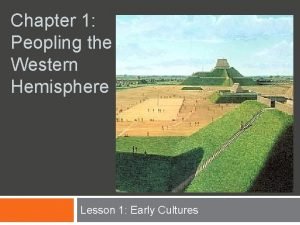Genetic Improvement Of Castor In the Western Hemisphere





























- Slides: 29

Genetic Improvement Of Castor In the Western Hemisphere Dick Auld – TTU/ TX Agri. Life Research Steve Oswalt – Texas Tech University Travis Miller – Texas Agri. Life Extension Carlos Demant – UNESP/ TTU Mauricio Zanotto – UNESP (Brazil) Liv Severino – EMBRAPA (Brazil) Alejandro Navas – CORPOICA (Columbia)

Castor Genetic Improvement “The Rest of the U. S. A Team” Brian Baldwin – MSU Tom Mc. Keon – USDA-ARS (Albany) Grace Chen – USDA-ARS (Albany) Calvin Trostle – Texas Agri. Life Ext. Mike Foster – Texas Agri. Life Research Tom Kilcer – Cornell Extension Alan Taylor – Cornell Geneva Ctr. Bill Crosby – Univ. of Windsor (Canada)

Mamona (Portuguese) A Lady of Dubious Character And the Castor Plant “A Little Dangerous” “Slightly Hot Blooded” “Very Promiscuous”

Mamona - Castor “A Little Dangerous” Ricin Toxin “Slightly Hot Blooded” World Wide in the Tropics “Very Promiscuous” Pollinates Over Five Miles

Tracking pollen flow in Mississippi USA 99. 8% of all pollen limited to 6 -6. 5 m

Castor Improvement for Biodiesel & Industrial Oil for All America ** * *** * * * *

Castor - (Ricinus communis L. ) § § § Seed Yield: 1000 to 3, 360 kg/ha Oil Content: 45 to 60% (500 to 1, 800 l/ha) Fatty Acids: 85% ricinoleic acid Disadvantages: Ricin & Allergens Advantages: Highest Oil Yields of Any Temperately Adapted Oilseed Crop Plant

C a s t o r Future Castor Research Improved Water Use Genetic Yield Enhancement Reduced Ricin Toxin

Conventional Genetics to Reduce Ricin Levels in Castor 2003 - Release TTU LRC Germplasm Crop Sci 43 : 746 -747 2009 - Release of ‘Brigham’ Castor Hale = 4, 210 ug/ml (38% Total Proteins) Brigham = 416 ug/ml (4% Total Proteins) 2012 – Future Castor Varieties Mc. Keon = 40 ug/ml (0. 4% Total Proteins)

Three University Collaboration § § Tissue culture Elimination of ricin by genetic transformation Elimination of the allergens Leading to safe castor

Dryland Castor Production in North East Brazil

Hand Harvested

Lack of Local Transportation

Limited Mechanized Harvest

Columbia, U. S. , & Brazil Charter Members of the “Mamona Mafia”

Excellent Drought Tolerance

Salt Tolerance

Hybrid Vigor

Genetic Diversity

Genetic Diversity

Broad Adaptation

North American Castor Production § High Yielding & Adapted Varieties § Drought & Salt Tolerant Varieties § Mechanized Production & Harvesting § Cost Effective & Sustainable Production

Production of Castor on the Texas High Plains 1. 2. 3. 4. Semi-dwarf Plant Varieties. Apply Plant Growth Regulators. Fully Mechanized Production on Marginal Land. “ Most Economical Source of Industrial Oil Feedstocks”

Production Field of ‘Hale’ Castor Lubbock, Texas in 2008

Production Field of ‘Hale’ Castor Memphis, Tennessee in 2006

Combine Harvest of ‘Hale’ Castor Seed

Castor Seed in Combine Prior to Cleaning Clean Seed Yield Exceeded 3, 000 kg/ha

Castor has a Promising Future

Acknowledgement § Texas Agri. Life Research and Extension and Texas Tech University § Ms. Marjorie Klayman Alnor Oil Company, Inc. § Dr. Travis Miller – Texas A&M § Dr. John B. Morris (USDA-ARS) Griffin, GA (Germplasm)
 Western and eastern hemisphere
Western and eastern hemisphere Spring summer winter fall
Spring summer winter fall Map of the western hemisphere
Map of the western hemisphere Western hemisphere
Western hemisphere Physical map of western hemisphere
Physical map of western hemisphere Map of western hemisphere blank
Map of western hemisphere blank Landforms in the western hemisphere
Landforms in the western hemisphere Genetic drift vs genetic flow
Genetic drift vs genetic flow What is the difference between genetic drift and gene flow
What is the difference between genetic drift and gene flow Genetic programming vs genetic algorithm
Genetic programming vs genetic algorithm Genetic programming vs genetic algorithm
Genetic programming vs genetic algorithm A gene pool consists of
A gene pool consists of Castor data management
Castor data management Nidos de castores
Nidos de castores Unternehmensstrategien arten
Unternehmensstrategien arten Sirius og castor
Sirius og castor Castor plateforme
Castor plateforme Saponification value significance
Saponification value significance Castor db
Castor db Poesie le dernier sapin de truchi
Poesie le dernier sapin de truchi Christine castor
Christine castor Số nguyên tố là
Số nguyên tố là Vẽ hình chiếu vuông góc của vật thể sau
Vẽ hình chiếu vuông góc của vật thể sau đặc điểm cơ thể của người tối cổ
đặc điểm cơ thể của người tối cổ Các châu lục và đại dương trên thế giới
Các châu lục và đại dương trên thế giới Tư thế worm breton là gì
Tư thế worm breton là gì Hệ hô hấp
Hệ hô hấp ưu thế lai là gì
ưu thế lai là gì Tư thế ngồi viết
Tư thế ngồi viết Cái miệng xinh xinh thế chỉ nói điều hay thôi
Cái miệng xinh xinh thế chỉ nói điều hay thôi












